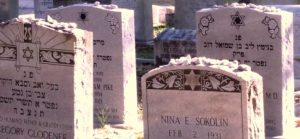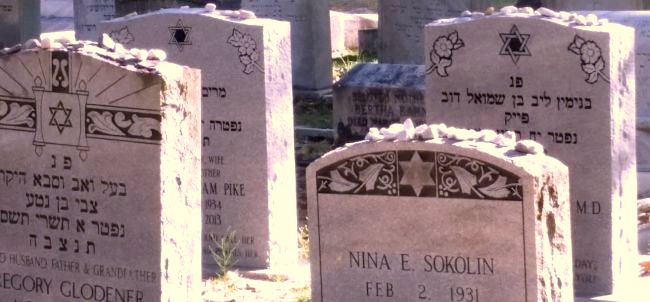
A discussion of Halachic topics related to the Parsha of the week. For final rulings, consult your Rav.
PROPER CONDUCT
Upon entering a cemetery, the blessing of asher yatzar eschem badin is recited.(1) The full text is found in many siddurim. This blessing is recited only once within any thirty-day period.(2) Before visiting at a grave, one should wash his hands.(3) Upon reaching the grave, one should place his left hand on the marker.(4) It is forbidden, though, to lean on it.(5) One should be careful not to step on any grave.(6) The same grave should not be visited twice in one day.(7)
Within four amos [6-8 feet] of a grave:(8)
- The tzitzis strings should be concealed.(9)
- Levity, eating, drinking, greeting a friend or engaging in business is prohibited.(10)
- Learning, davening or reciting a blessing is prohibited.(11) Many poskim, however, hold that it is permitted to recite Tehillim(12) or the burial Kaddish.(13)
LEAVING A CEMETERY
Before taking leave of a grave it is customary to put a stone or some grass on the marker.(14)
Upon leaving the cemetery, it is customary to take some soil and grass from the ground and throw it over one’s shoulder.(15) There are many different reasons for this custom. On Shabbos, Yom Tov and Chol ha-Moed this may not be done.(16)
After leaving a cemetery and before entering one’s home(17) or another person’s home,(18) one should wash his hands three times from a vessel, alternating between the right and left hands.(19) There are different customs concerning the method of washing(20): The water should drain into the ground and not collect in a puddle. After washing, any water that remains in the vessel is poured out. The vessel is turned upside down and placed on the ground, not handed to the next person.(21) Some let their hands air dry and do not use a towel.(22) Some wash their face as well.(23)
FOOTNOTES:
1 O.C. 224:12. This blessing is recited only in an area where there are at least two graves.
2 Mishnah Berurah 224:17.
3 Mishnah Berurah 4:42.
4 Kitzur Shulchan Aruch 128:13. See there also for the text that should be recited at that time.
5 Shach Y.D. 363:3.
6 Taz Y.D. 363:1.
7 Mishnah Berurah 581:27.
8 Note that according to the Ari z”l (quoted by Mishnah Berurah 559:41), one should never go within four amos of a grave [except at interment]. In Igeres ha-Gra he writes that one should never enter a cemetery at all, and especially not women. [It is commonly accepted that a woman who is a niddah does not go to a cemetery at all (Mishnah Berurah 88:7). Under extenuating circumstances a rabbi should be consulted; see Beis Baruch on Chayei Adam 3:38.]
9 Mishnah Berurah 23:3. Tefillin, too, must be concealed.
10 Y.D. 368:1; Rama Y.D. 343:2.
11 Y.D. 367:3; 368:1.
12 Birkei Yosef Y.D. 344:17.
13 Gesher ha-Chayim 1:16-4.
14 Be’er Heitev O.C. 224:8.
15 Y.D. 376:4. Some do this only after an interment.
16 O.C. 547:12.
17 Kaf ha-Chayim 4:80.
18 Mishnah Berurah 4:43. It is permitted, however, to enter a shul or another public place before washing; Harav M. Feinstein (Moadei Yeshurun, pg. 58).
19 Mishnah Berurah 4:39.
20 Some of these customs do not have a halachic source; they are based on Kabbalistic writings and customs.
21 Rav Akiva Eiger (Y.D. 376:4). See Zichron Meir, pg. 450.
22 Several poskim write that this does not apply during the cold winter months when the hands will become chapped; see Kaf ha-Chayim 4:78.
23 Mishnah Berurah 4:42.


